Sizing Accuracy of Low-Cost Optical Particle Sensors Under Controlled Laboratory Conditions
Abstract
:1. Introduction
2. Materials and Methods
2.1. Evaluated Low-Cost Sensors and Research-Grade Instruments
2.2. Experimental Setup
3. Results
3.1. Monodisperse Particles Measured by Reference Instruments
3.2. Sizing Accuracy of OPC-N3 and DRX
3.3. Sizing Accuracy of PMS5003 and SPS30
3.4. Mass Distribution of PM1, PM1–2.5, and PM2.5–10 Measured with SPS30, PMS5003, and DRX
3.5. Ambient PM2.5 and PM10 Measured with SPS30 and Beta-Attenuation Monitors
4. Conclusions and Discussion
Supplementary Materials
Author Contributions
Funding
Institutional Review Board Statement
Informed Consent Statement
Data Availability Statement
Conflicts of Interest
References
- Feng, S.; Gao, D.; Liao, F.; Zhou, F.; Wang, X. The health effects of ambient PM2.5 and potential mechanisms. Ecotoxicol. Environ. Saf. 2016, 128, 67–74. [Google Scholar] [CrossRef] [PubMed]
- Fuzzi, S.; Baltensperger, U.; Carslaw, K.; Decesari, S.; Denier van der Gon, H.; Facchini, M.C.; Fowler, D.; Koren, I.; Langford, B.; Lohmann, U.; et al. Particulate matter, air quality and climate: Lessons learned and future needs. Atmos. Chem. Phys. 2015, 15, 8217–8299. [Google Scholar] [CrossRef]
- Watson, J.G. Visibility: Science and regulation. J. Air Waste Manage. Assoc. 2002, 52, 628–713. [Google Scholar]
- U.S. EPA. Integrated Science Assessment (ISA) for Particulate Matter (Final Report, Dec 2019); U.S. Environmental Protection Agency (U.S. EPA): Washington, DC, USA, 2019. Available online: https://ordspub.epa.gov/ords/eims/eimscomm.getfile?p_download_id=539935 (accessed on 29 October 2024).
- U.S. EPA. Supplement to the 2019 Integrated Science Assessment for Particulate Matter (Final Report, 2022); U.S. Environmental Protection Agency (U.S. EPA): Washington, DC, USA, 2022. Available online: https://ordspub.epa.gov/ords/eims/eimscomm.getfile?p_download_id=544706 (accessed on 29 October 2024).
- Wilson, W.E.; Chow, J.C.; Claiborn, C.; Fusheng, W.; Engelbrecht, J.; Watson, J.G. Monitoring of particulate matter outdoors. Chemosphere 2002, 49, 1009–1043. [Google Scholar] [CrossRef] [PubMed]
- Alfano, B.; Barretta, L.; Del Giudice, A.; De Vito, S.; Di Francia, G.; Esposito, E.; Formisano, F.; Massera, E.; Miglietta, M.L.; Polichetti, T. A Review of Low-Cost Particulate Matter Sensors from the Developers’ Perspectives. Sensors 2020, 20, 6819. [Google Scholar] [CrossRef]
- U.S. EPA. List of Designated Reference and Equivalent Methods; Research Triangle Park, NC, 15 December 2024. Available online: https://www.epa.gov/system/files/documents/2024-12/amtic-list-december-2024_final.pdf (accessed on 22 February 2025).
- Snyder, E.G.; Watkins, T.H.; Solomon, P.A.; Thoma, E.D.; Williams, R.W.; Hagler, G.S.W.; Shelow, D.; Hindin, D.A.; Kilaru, V.J.; Preuss, P.W. The Changing Paradigm of Air Pollution Monitoring. Environ. Sci. Technol. 2013, 47, 11369–11377. [Google Scholar] [CrossRef] [PubMed]
- deSouza, P.; Barkjohn, K.; Clements, A.; Lee, J.; Kahn, R.; Crawford, B.; Kinney, P. An analysis of degradation in low-cost particulate matter sensors. Environ. Sci. Atmos. 2023, 3, 521–536. [Google Scholar] [CrossRef]
- Giordano, M.R.; Malings, C.; Pandis, S.N.; Presto, A.A.; McNeill, V.F.; Westervelt, D.M.; Beekmann, M.; Subramanian, R. From low-cost sensors to high-quality data: A summary of challenges and best practices for effectively calibrating low-cost particulate matter mass sensors. J. Aerosol Sci. 2021, 158, 105833. [Google Scholar] [CrossRef]
- Wang, X.L.; Chancellor, G.; Evenstad, J.; Farnsworth, J.E.; Hase, A.; Olson, G.M.; Sreenath, A.; Agarwal, J.K. A Novel Optical Instrument for Estimating Size Segregated Aerosol Mass Concentration in Real Time. Aerosol Sci. Technol. 2009, 43, 939–950. [Google Scholar] [CrossRef]
- Hagan, D.H.; Kroll, J.H. Assessing the accuracy of low-cost optical particle sensors using a physics-based approach. Atmos. Meas. Tech. 2020, 13, 6343–6355. [Google Scholar] [CrossRef]
- Gebhart, J. Optical Direct-Reading Techniques: Light Intensity Systems. In Aerosol Measurement: Principles, Techniques, and Applications, 2nd ed.; Baron, P.A., Willeke, K., Eds.; John Wiley & Sons, Inc.: New York, NY, USA, 2001; pp. 419–454. [Google Scholar]
- Binnig, J.; Meyer, J.; Kasper, G. Calibration of an optical particle counter to provide PM2.5 mass for well-defined particle materials. J. Aerosol Sci. 2007, 38, 325–332. [Google Scholar] [CrossRef]
- Whitby, K.T.; Willeke, K. Single Particle Optical Counters: Principles and Field Use. In Aerosol Measurement; Lundgren, D.A., Lippmann, M., Harris, F.S., Clark, W.E., Marlow, W.H., Durham, M.D., Eds.; University Presses of Florida: Gainesville, FL, USA, 1979; pp. 145–182. [Google Scholar]
- EN 16450; Ambient Air—Automated Measuring Systems for the Measurement of the Concentration of Particulate Matter (PM10; PM2,5). European Committee for Standardization: Brussels, Belgium, 2017. Available online: https://standards.iteh.ai/catalog/standards/cen (accessed on 30 March 2025).
- Mehadi, A.; Moosmüller, H.; Campbell, D.E.; Ham, W.; Schweizer, D.; Tarnay, L.; Hunter, J. Laboratory and Field Evaluation of Real-time and Near Real-time PM2.5 Smoke Monitors. J. Air Waste Manag. Assoc. 2020, 70, 158–179. [Google Scholar] [CrossRef]
- Kaur, K.; Kelly, K.E. Performance evaluation of the Alphasense OPC-N3 and Plantower PMS5003 sensor in measuring dust events in the Salt Lake Valley, Utah. Atmos. Meas. Tech. 2023, 16, 2455–2470. [Google Scholar] [CrossRef]
- Kosmopoulos, G.; Salamalikis, V.; Pandis, S.N.; Yannopoulos, P.; Bloutsos, A.A.; Kazantzidis, A. Low-cost sensors for measuring airborne particulate matter: Field evaluation and calibration at a South-Eastern European site. Sci. Total Environ. 2020, 748, 141396. [Google Scholar] [CrossRef]
- Mei, H.; Han, P.; Wang, Y.; Zeng, N.; Liu, D.; Cai, Q.; Deng, Z.; Wang, Y.; Pan, Y.; Tang, X. Field Evaluation of Low-Cost Particulate Matter Sensors in Beijing. Sensors 2020, 20, 4381. [Google Scholar] [CrossRef]
- Molina Rueda, E.; Carter, E.; L’Orange, C.; Quinn, C.; Volckens, J. Size-Resolved Field Performance of Low-Cost Sensors for Particulate Matter Air Pollution. Environ. Sci. Technol. Lett. 2023, 10, 247–253. [Google Scholar] [CrossRef] [PubMed]
- Sensirion. Sensor Specification Statement: How to Understand Specifications of Sensirion Particulate Matter Sensors; Sensirion AG: Staefa, Switzerland, 2020; Available online: https://sensirion.com/media/documents/B7AAA101/61653FB8/Sensirion_Particulate_Matter_AppNotes_Specification_Statement.pdf (accessed on 1 December 2024).
- Ouimette, J.; Arnott, W.P.; Laven, P.; Whitwell, R.; Radhakrishnan, N.; Dhaniyala, S.; Sandink, M.; Tryner, J.; Volckens, J. Fundamentals of low-cost aerosol sensor design and operation. Aerosol Sci. Technol. 2024, 58, 1–15. [Google Scholar] [CrossRef]
- He, M.; Kuerbanjiang, N.; Dhaniyala, S. Performance characteristics of the low-cost Plantower PMS optical sensor. Aerosol Sci. Technol. 2020, 54, 232–241. [Google Scholar] [CrossRef]
- Kuula, J.; Mäkelä, T.; Aurela, M.; Teinilä, K.; Varjonen, S.; González, Ó.; Timonen, H. Laboratory evaluation of particle-size selectivity of optical low-cost particulate matter sensors. Atmos. Meas. Tech. 2020, 13, 2413–2423. [Google Scholar] [CrossRef]
- Kaur, K.; Kelly, K.E. Laboratory evaluation of the Alphasense OPC-N3, and the Plantower PMS5003 and PMS6003 sensors. J. Aerosol Sci. 2023, 171, 106181. [Google Scholar] [CrossRef]
- Barkjohn, K.K.; Gantt, B.; Clements, A.L. Development and application of a United States-wide correction for PM2.5 data collected with the PurpleAir sensor. Atmos. Meas. Tech. 2021, 14, 4617–4637. [Google Scholar] [CrossRef] [PubMed]
- Wallace, L. Testing a New “Decrypted” Algorithm for Plantower Sensors Measuring PM2.5: Comparison with an Alternative Algorithm. Algorithms 2023, 16, 392. [Google Scholar] [CrossRef]
- Wallace, L. Cracking the code—Matching a proprietary algorithm for a low-cost sensor measuring PM1 and PM2.5. Sci. Total Environ. 2023, 893, 164874. [Google Scholar] [CrossRef]
- Wang, X.L.; Zhou, H.; Arnott, W.P.; Meyer, M.E.; Taylor, S.; Firouzkouhi, H.; Moosmüller, H.; Chow, J.C.; Watson, J.G. Evaluation of Gas and Particle Sensors for Detecting Spacecraft-Relevant Fire Emissions. Fire Saf. J. 2020, 113, 1–12. [Google Scholar] [CrossRef]
- He, R.; Han, T.; Bachman, D.; Carluccio, D.J.; Jaeger, R.; Zhang, J.; Thirumurugesan, S.; Andrews, C.; Mainelis, G. Evaluation of two low-cost PM monitors under different laboratory and indoor conditions. Aerosol Sci. Technol. 2020, 55, 316–331. [Google Scholar] [CrossRef]
- ISO 21501-1:2009; Determination of Particle Size Distribution—Single Particle Light Interaction Methods—Part 1: Light Scattering Aerosol Spectrometer. International Organization for Standardization: Geneva, Switzerland, 2009.
- TSI. Optical Particle Sizer: Model 3330; TSI Inc.: Shoreview, MN, USA, 2024; Available online: https://tsi.com/getmedia/9728dd3d-5528-4621-9877-a116ee742528/3330_5001323_Web?ext=.pdf (accessed on 2 December 2024).
- Vasilatou, K.; Wälchli, C.; Koust, S.; Horender, S.; Iida, K.; Sakurai, H.; Schneider, F.; Spielvogel, J.; Wu, T.Y.; Auderset, K. Calibration of optical particle size spectrometers against a primary standard: Counting efficiency profile of the TSI Model 3330 OPS and Grimm 11-D monitor in the particle size range from 300 nm to 10 μm. J. Aerosol Sci. 2021, 157, 105818. [Google Scholar] [CrossRef]
- Baron, P.A. Calibration and Use of the Aerodynamic Particle Sizer (APS 3300). Aerosol Sci. Technol. 1986, 5, 55–67. [Google Scholar] [CrossRef]
- Peters, T.M. Use of the Aerodynamic Particle Sizer to Measure Ambient PM10–2.5: The Coarse Fraction of PM10. J. Air Waste Manage. Assoc. 2006, 56, 411–416. [Google Scholar] [CrossRef]
- Tryner, J.; Mehaffy, J.; Miller-Lionberg, D.; Volckens, J. Effects of aerosol type and simulated aging on performance of low-cost PM sensors. J. Aerosol Sci. 2020, 150, 105654. [Google Scholar] [CrossRef]
- Rader, D.J.; McMurry, P.H.; Smith, S. Evaporation Rates of Monodisperse Organic Aerosols in the 0.02- to 0.2-µm-Diameter Range. Aerosol Sci. Technol. 1987, 6, 247–260. [Google Scholar] [CrossRef]
- Sang-Nourpour, N.; Olfert, J.S. Calibration of optical particle counters with an aerodynamic aerosol classifier. J. Aerosol Sci. 2019, 138, 105452. [Google Scholar] [CrossRef]
- Hinds, W.C. Aerosol Technology, Properties, Behavior, and Measurement of Airborne Particles, 2nd ed.; A Wiley-Interscience Publication: Los Angeles, CA, USA, 1999. [Google Scholar]
- Flagan, R.C. On Differential Mobility Analyzer Resolution. Aerosol Sci. Technol. 1999, 30, 556–570. [Google Scholar] [CrossRef]
- Wang, X.L.; Caldow, R.; Sem, G.J.; Hama, N.; Sakurai, H. Evaluation of a condensation particle counter for vehicle emission measurement: Experimental procedure and effects of calibration aerosol material. J. Aerosol Sci. 2010, 41, 306–318. [Google Scholar] [CrossRef]
- Duan, H.; Romay, F.J.; Li, C.; Naqwi, A.; Deng, W.; Liu, B.Y.H. Generation of monodisperse aerosols by combining aerodynamic flow-focusing and mechanical perturbation. Aerosol Sci. Technol. 2016, 50, 17–25. [Google Scholar] [CrossRef]
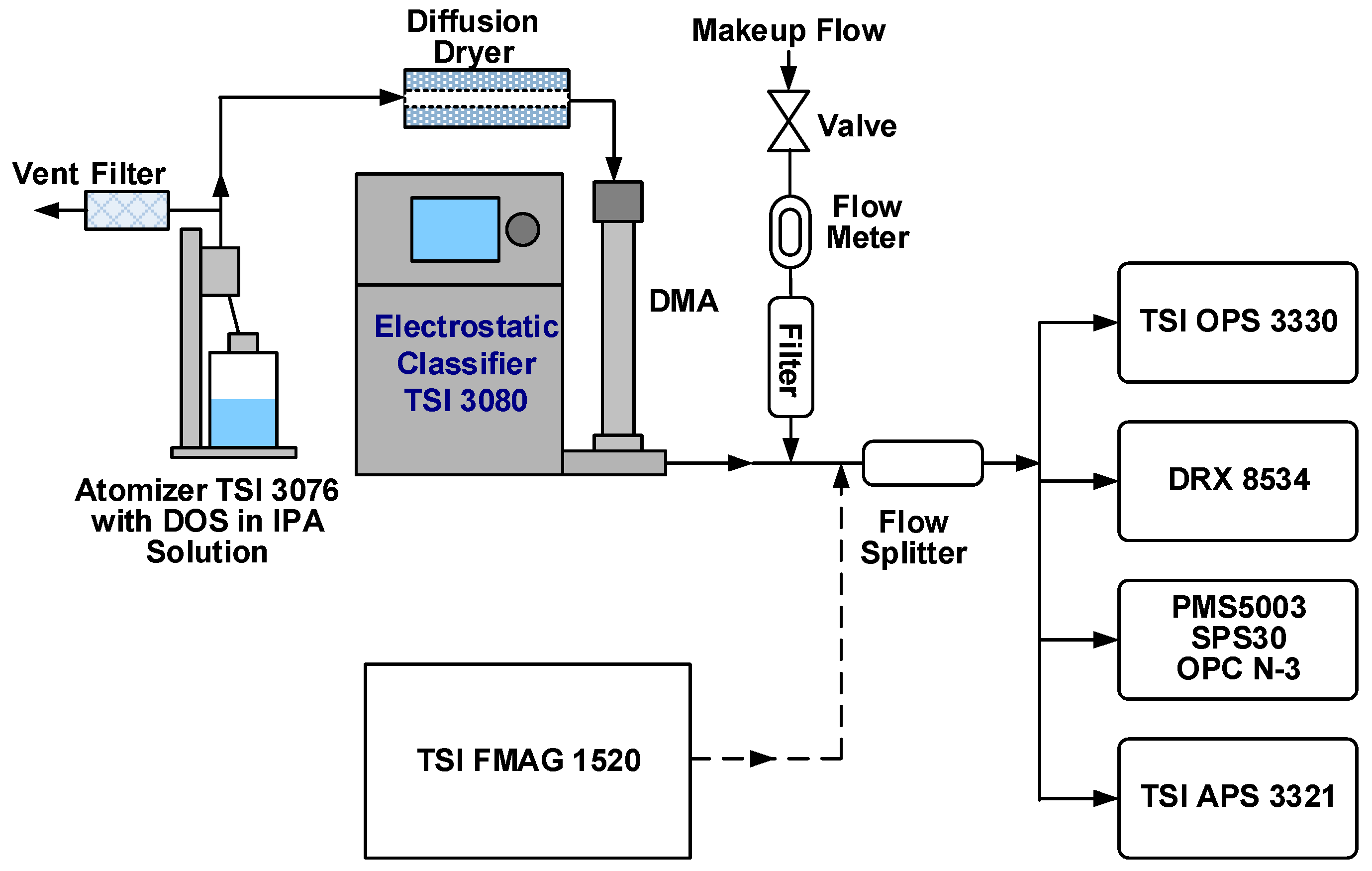
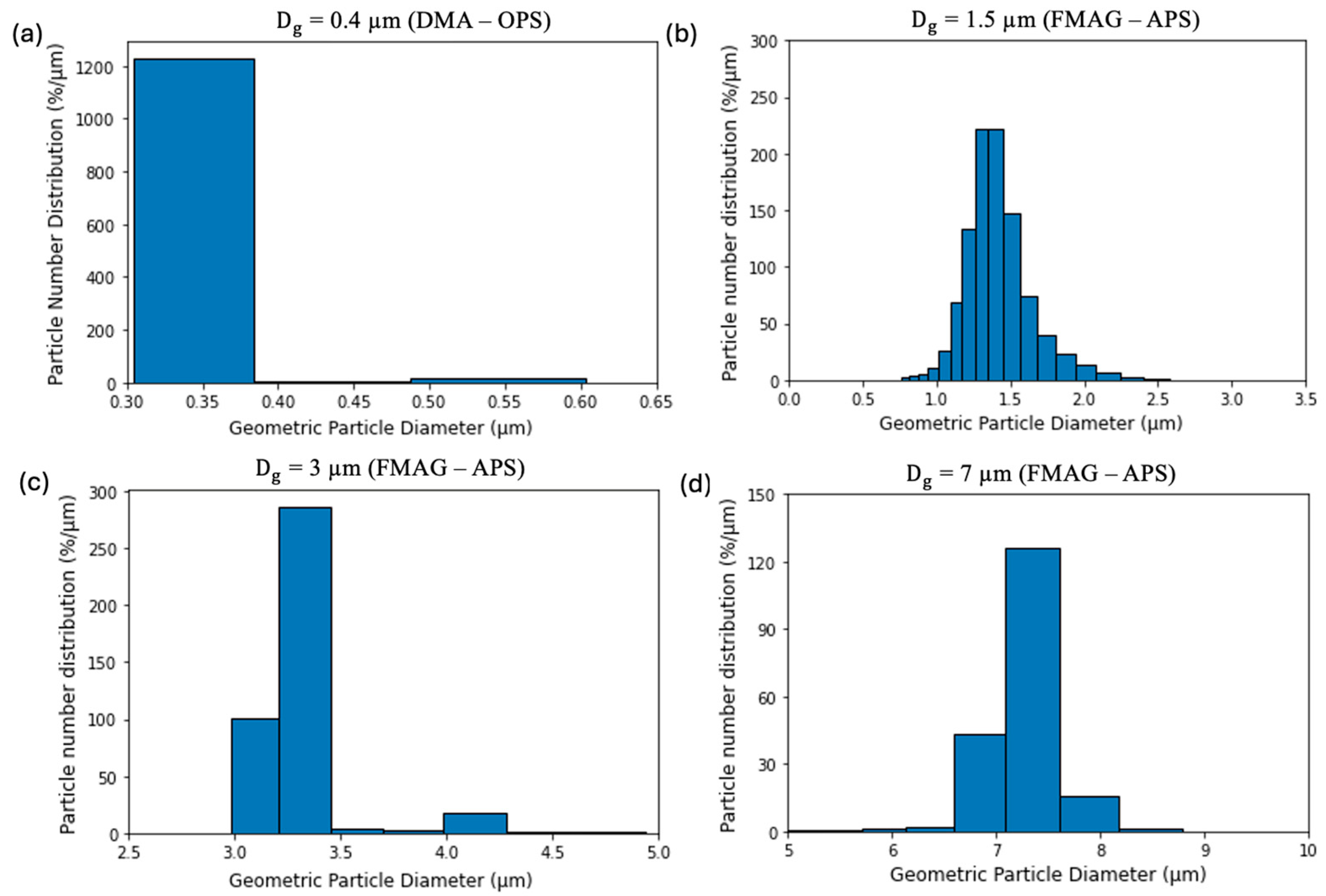
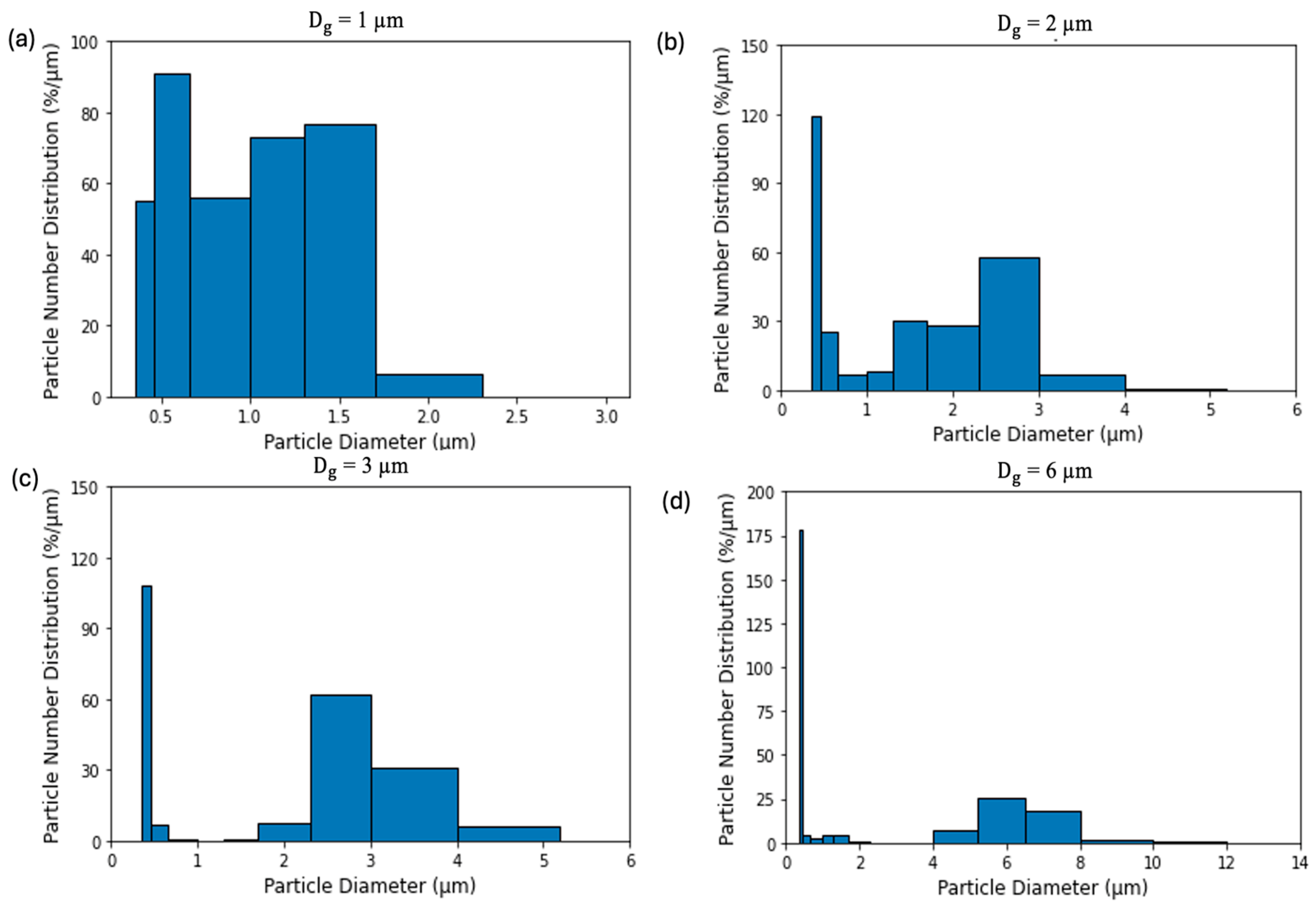
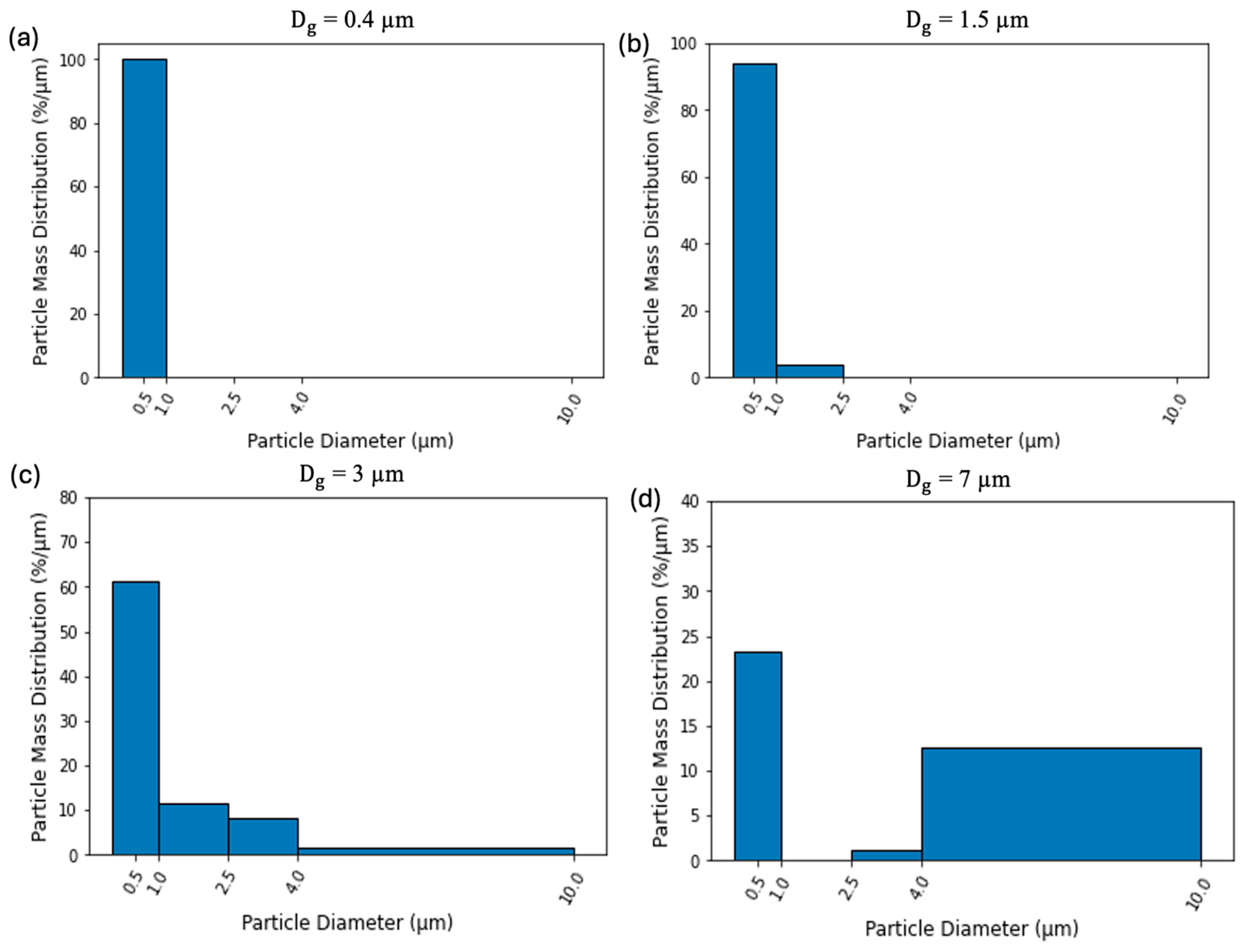
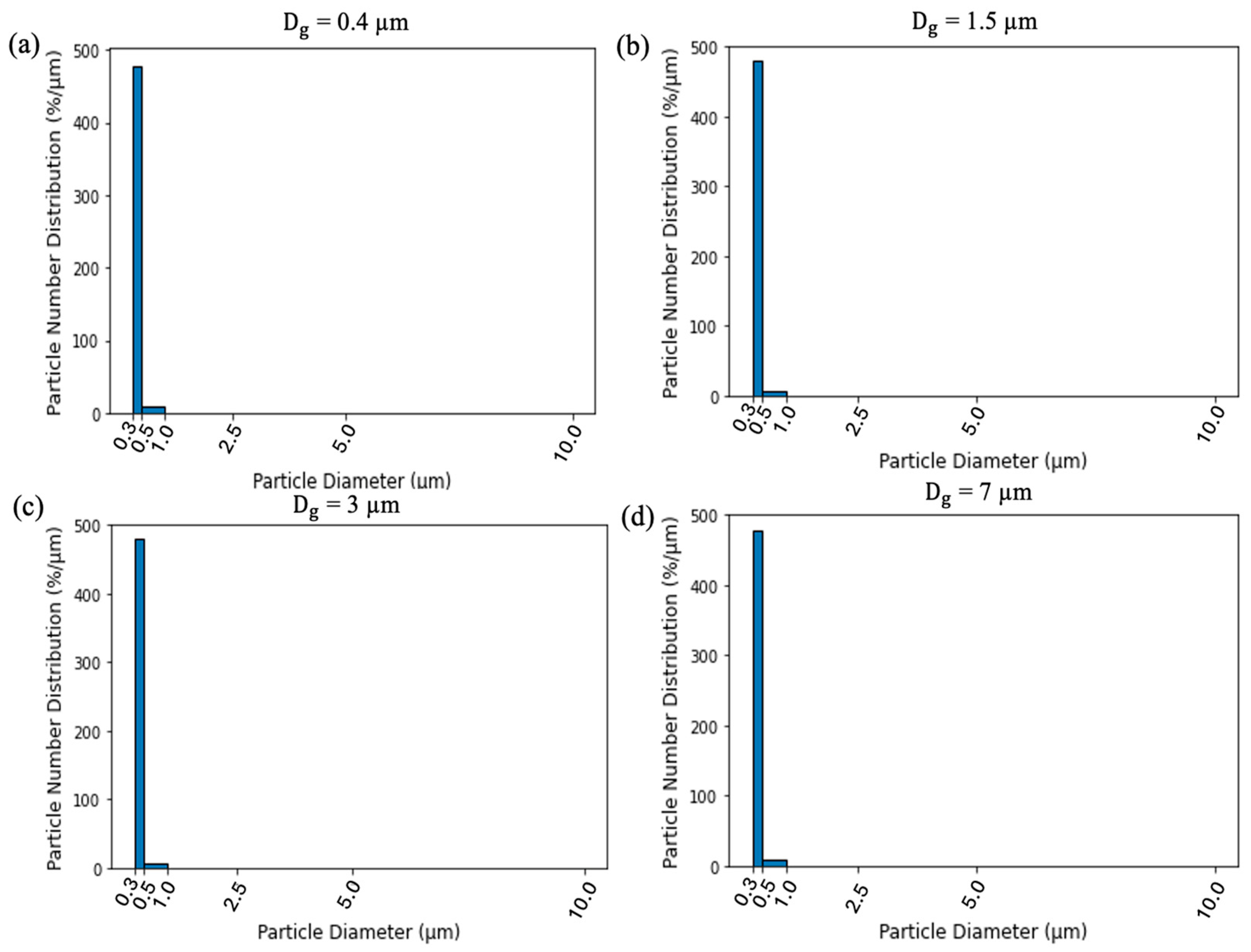

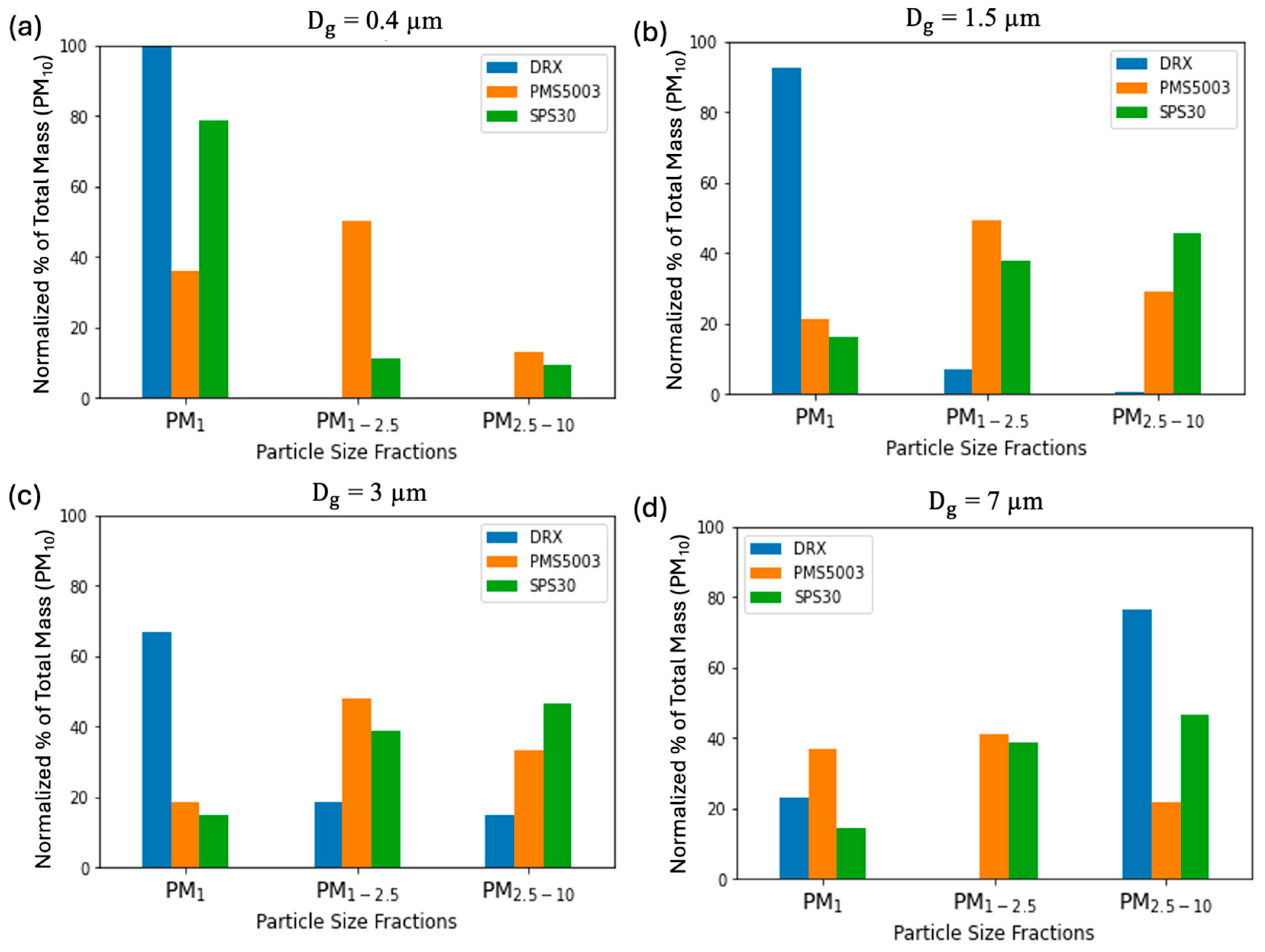
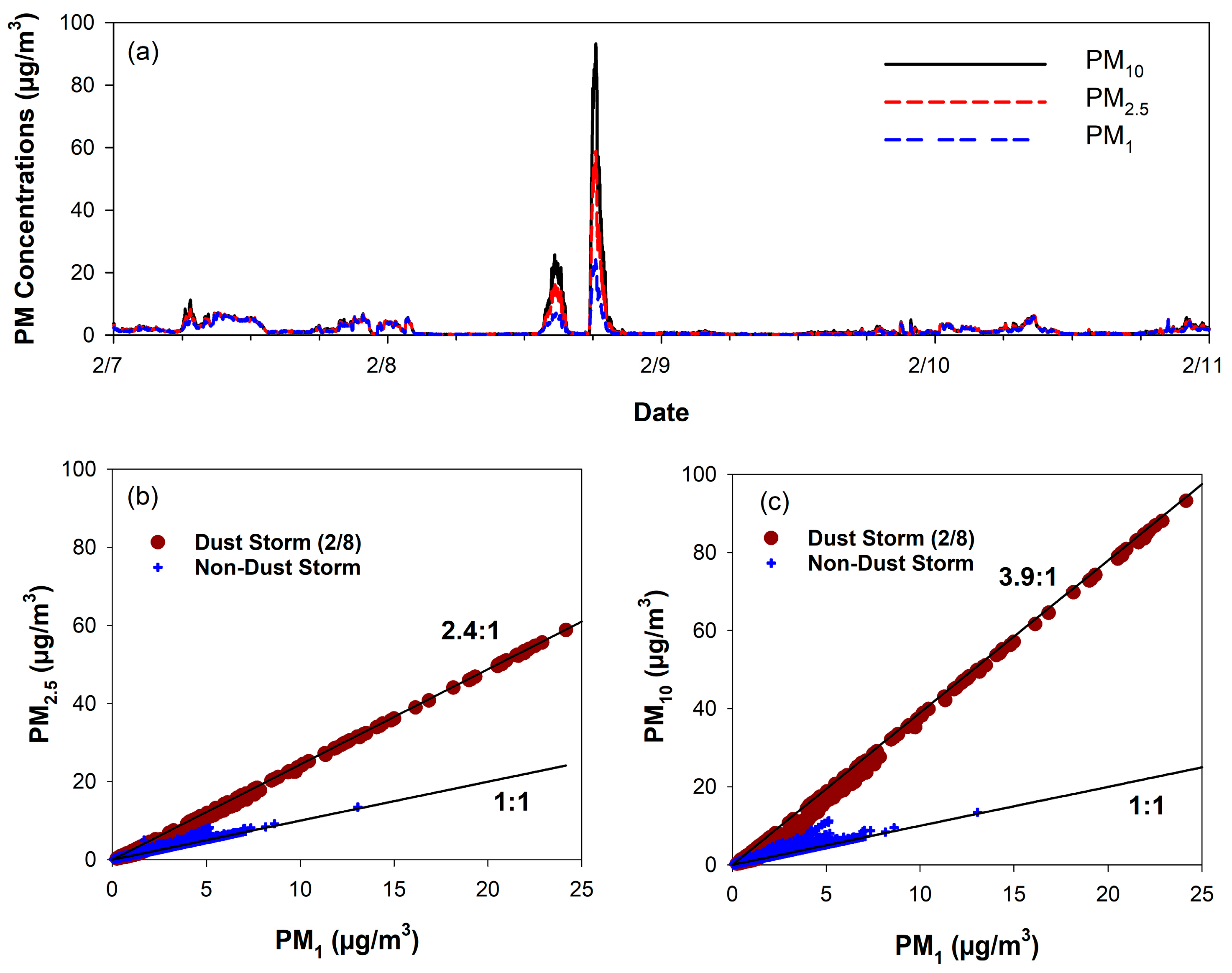
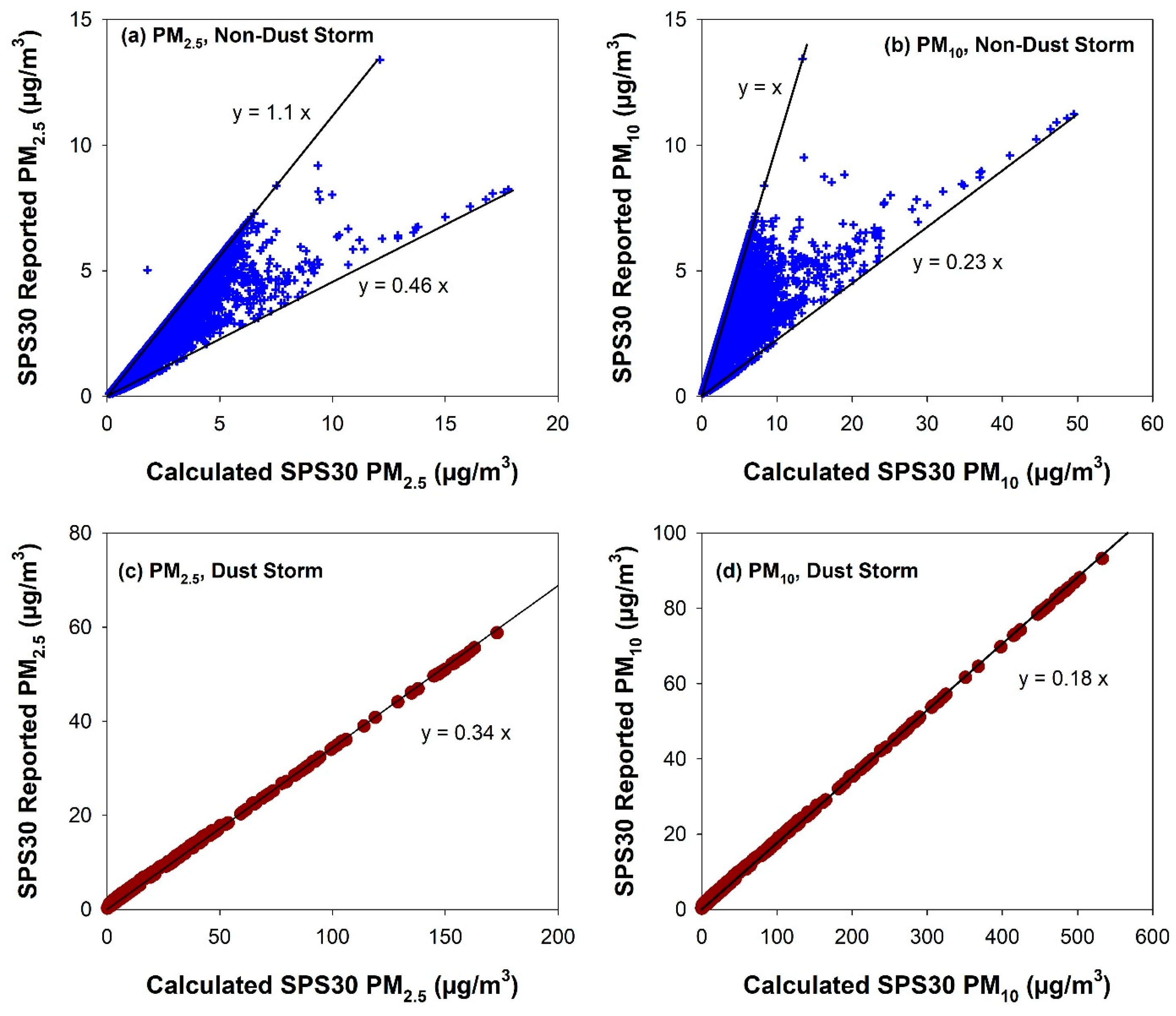
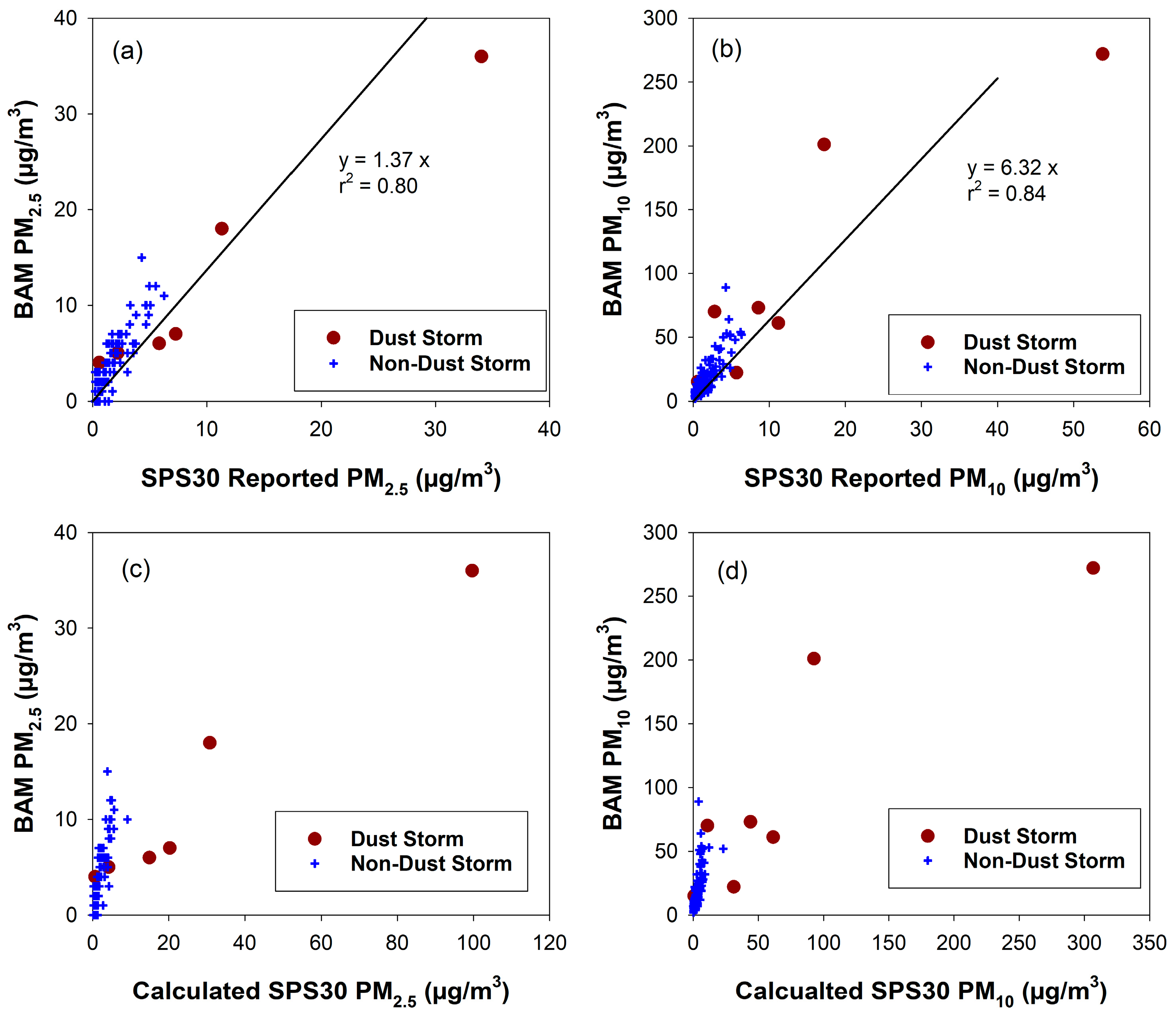
| Sensor/Instruments | Scattering Angle | Wavelength | Output | Price (USD) |
|---|---|---|---|---|
| OPC-N3 | 32–88° | 658 nm | PM1, PM2.5, PM10, and number concentrations for 0.35–40 µm in 24 channels | ~500 |
| Plantower PMS5003 | 90 ± 37° | 657 nm | PM1, PM2.5, PM10, and number concentrations for >0.3, >0.5, >1, >2.5, >5, and >10 µm | ~20 |
| Sensirion SPS30 | Data not available | 660 nm | PM1, PM2.5, PM4, PM10, and number concentrations for 0.3–0.5, 0.3–1, 0.3–2.5, 0.3–4, and 0.3–10 µm | ~50 |
| TSI DRX 8534 | 90 ± 62° | 655 nm | PM1, PM2.5, PM4, PM10, and total PM | ~11,000 |
| TSI OPS 3330 | 90 ± 60° | 660 nm | Number, surface area, and mass distributions for 0.3–10 μm in up to 16 channels | ~19,000 |
| TSI APS 3321 | Aerodynamic particle sizing | Aerodynamic size distribution for 0.5–20 µm in 52 channels | ~57,000 | |
| Sizes (µm) | PM2.5/PM1 Mass Ratio | PM10/PM2.5 Mass Ratio | PM10/PM1 Mass Ratio | |||
|---|---|---|---|---|---|---|
| PMS5003 | SPS30 | PMS5003 | SPS30 | PMS5003 | SPS30 | |
| 0.4 | 2.39 | 1.14 | 1.15 | 1.10 | 2.75 | 1.25 |
| 0.6 | 2.26 | 1.26 | 1.36 | 1.21 | 3.07 | 1.52 |
| 1 | 3.17 | 3.10 | 1.37 | 1.80 | 4.34 | 5.58 |
| 1.5 | 3.30 | 3.31 | 1.40 | 1.84 | 4.62 | 6.09 |
| 2 | 3.50 | 3.55 | 1.47 | 1.86 | 5.15 | 6.60 |
| 3 | 3.56 | 3.61 | 1.50 | 1.87 | 5.34 | 6.75 |
| 6 | 3.25 | 3.53 | 1.35 | 1.84 | 4.39 | 6.50 |
| 7 | 2.12 | 3.68 | 1.28 | 1.88 | 2.71 | 6.92 |
Disclaimer/Publisher’s Note: The statements, opinions and data contained in all publications are solely those of the individual author(s) and contributor(s) and not of MDPI and/or the editor(s). MDPI and/or the editor(s) disclaim responsibility for any injury to people or property resulting from any ideas, methods, instructions or products referred to in the content. |
© 2025 by the authors. Licensee MDPI, Basel, Switzerland. This article is an open access article distributed under the terms and conditions of the Creative Commons Attribution (CC BY) license (https://creativecommons.org/licenses/by/4.0/).
Share and Cite
Gautam, P.; Ramirez, A.; Bair, S.; Arnott, W.P.; Chow, J.C.; Watson, J.G.; Moosmüller, H.; Wang, X. Sizing Accuracy of Low-Cost Optical Particle Sensors Under Controlled Laboratory Conditions. Atmosphere 2025, 16, 502. https://doi.org/10.3390/atmos16050502
Gautam P, Ramirez A, Bair S, Arnott WP, Chow JC, Watson JG, Moosmüller H, Wang X. Sizing Accuracy of Low-Cost Optical Particle Sensors Under Controlled Laboratory Conditions. Atmosphere. 2025; 16(5):502. https://doi.org/10.3390/atmos16050502
Chicago/Turabian StyleGautam, Prakash, Andrew Ramirez, Salix Bair, William Patrick Arnott, Judith C. Chow, John G. Watson, Hans Moosmüller, and Xiaoliang Wang. 2025. "Sizing Accuracy of Low-Cost Optical Particle Sensors Under Controlled Laboratory Conditions" Atmosphere 16, no. 5: 502. https://doi.org/10.3390/atmos16050502
APA StyleGautam, P., Ramirez, A., Bair, S., Arnott, W. P., Chow, J. C., Watson, J. G., Moosmüller, H., & Wang, X. (2025). Sizing Accuracy of Low-Cost Optical Particle Sensors Under Controlled Laboratory Conditions. Atmosphere, 16(5), 502. https://doi.org/10.3390/atmos16050502








